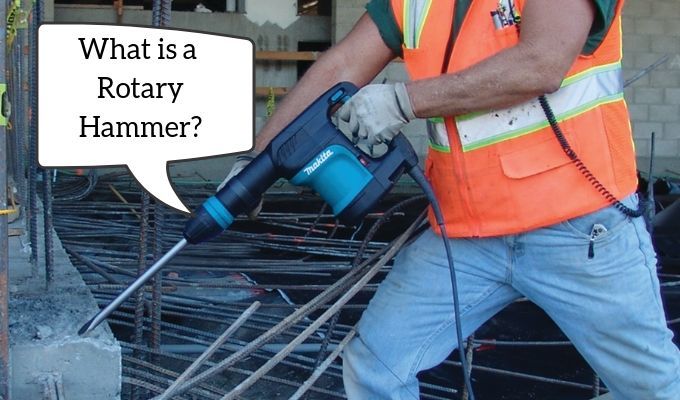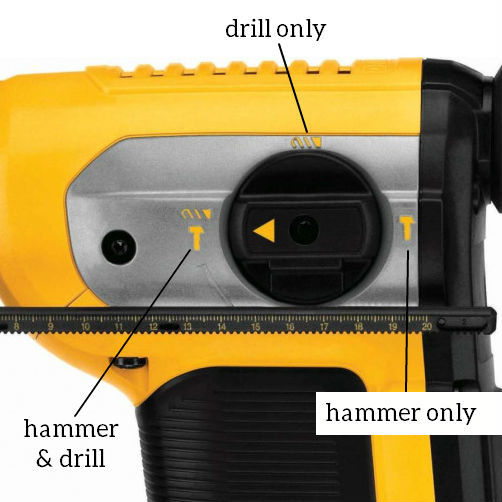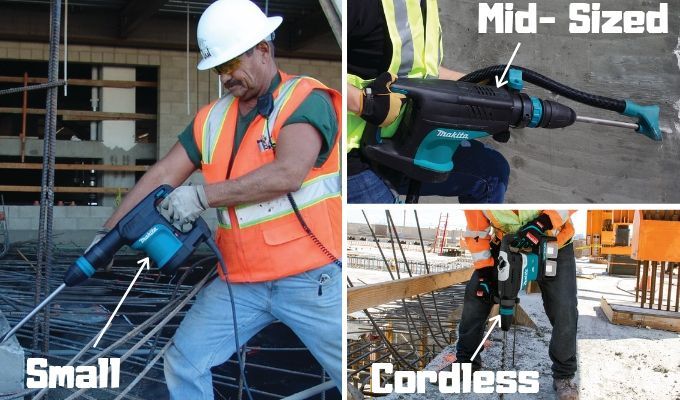
Rotary hammers are also known as pneumatic hammers/drills and are your big guns when it comes to one of your bigger remodeling, demolition or job site tasks – for drilling into the age-hardened concrete and masonry, there is really no substitute for a rotary hammer.
It’s simply the best tool for the job that calls for drilling a large number of holes, or if you need to use the largest bits you have to drill hole diameters over an inch or so. So, just what is a rotary hammer, and how does one of these heavy-duty power tools fit in with the rest of your toolbox?
What Is a Rotary Hammer, And How Does It Work?
Many power tools add some sort of hammering action to enhance the torque that they put out. Rotary hammers, on the other hand, do things the other way around – they are designed to deliver a powerful hammering action first, with torque and RPM being secondary.
Think of it as having a jackhammer where the business end of the tool also spins. Unlike hammer drills, impact drives and impact wrenches, rotary hammers generally spin at a slower speed, with just enough torque and rotation to drive the drill bit into reinforced concrete or masonry. What they have in plentiful supply, though, is the extremely powerful hammering action that they put out.
Most drilling power tools add cam disks or rotating weights to deliver a hammering action to the drive shaft and the drill bit. Rotary hammers, on the other hand, use a piston that is powered by a motor drive or compressed air. This arrangement actually lets you turn the rotation of your rotary hammer on or off, and you can use your tool with a “hammer only” action just like a mini jackhammer.
What Does a Rotary Hammer Do?
A rotary hammer uses a piston, that’s powered by the motor or by compressed air, to deliver a massive amount of hammering force on the bit. While conventional drills and hammer drills work mostly by shaving and pulling out material using the flutes of the drill bit, the rotary hammer works by pulverizing the material instead.
Many rotary hammers can operate in three modes as well – hammer mode, drill mode, and a combined hammer and drill mode. These options let you do more than just drill holes using your rotary hammer. With the right attachment, you can also things like chiseling, surface prep, breaking, demolition, or even digging.

A rotary hammer does all these while also mostly protecting the user from most of the rebound vibration produced by the hammering action. Many rotary hammer models are designed to use air pressure as a driving force in the piston, and also as a buffer for the rebound impact.
Thus cushion of air ensures that the piston head does not hit the rear of the piston – this also means that the rebound is not directly felt by the user holding the tool. This eliminates much of the handle vibration and noise that could lead to numbed hands and general discomfort.
What Do You Use a Rotary Hammer For?
Your primary use for a rotary hammer is to drill into concrete and masonry type of materials and demo the same materials too, mostly. In this application, few tools can even begin to approach the speed and efficiency of a rotary hammer or a breaker hammer.
For very hard and unyielding materials such as masonry, concrete, and stonework, the force of the impact produced by your tool becomes a greater factor than the rotational speed of the drill bit. Even with the relatively lower RPM rates of rotary hammers, they still offer a much faster drilling rate compared to hammer drills and conventional drills if you are dealing with these sorts of materials.
On the other hand, the relatively slow rotational speed of rotary hammers makes them a less than ideal choice for drilling into wood or metal. That is why rotary hammers are mostly reserved for jobs involving concrete and masonry, where their impact force and drilling efficiency through hard, brittle materials really shine.
Rotary hammers are the best tool of choice for drilling holes straight through concrete or masonry walls (making through-holes). They are also ideal for opening up large holes in concrete and masonry for rebar anchors, a repetitive drilling process known as “doweling”.
Electricians often turn to rotary hammers to set down concrete anchors for their equipment, and the same goes for any professional that needs to install and fix heavy equipment to a suitable concrete base.
With the right chisel, point or spade accessories, a rotary hammer that’s set to the “hammer only” setting can also be used for chipping, chiseling, and digging tasks.
What Size Rotary Hammer Should I Buy?
Choosing the right size of rotary hammer depends on the job you need to do with them – specifically, the size of holes that you will be drilling. For practical purposes, you may want to get the rotary hammer that can accommodate the largest bits you can expect to need.
When it comes to rotary hammer size, you have to consider two factors – the size of the tool itself, and the largest bits it can accommodate. When it comes to cordless rotary hammers, your choice basically falls down to two options – a more compact 12V model, or a more powerful 18V tool.
A compact model works well for installing ground anchors and other basic drilling jobs involving concrete. An 18V tool, on the other hand, lets you make through-holes in walls and make efficient use of larger bits, as well. Most 18V rotary hammers will also need you to use both hands to comfortably hold them, too.

When it comes to chuck sizes, you will find models that offer SDS and SDS Plus systems that are made for smaller bits. SDS stands for “slotted drive system”, “slotted drive shank”, or in the original German name, “steck, dreh, sitzt” which stand for “insert, twist, fits” Grooves run along the shank of a compatible SDS or SDS Plus bit to let the tool hold them in place.
Many SDS and SDS Plus bits will fit a rotary hammer using either standard, and they feature 10 mm shanks. At this range, you can expect to find bits from 3/16 inch to 3/4 inch in diameter.
You can expect an SDS or SDS Plus rotary hammer to be in the neighborhood of 8 pounds or less.
If you need to drill holes larger than an inch in diameter, your system of choice basically boils down to two: the older Spline standard and the newer SDS Max. Spline systems are becoming rarer on the market, but many professionals still hold on to them especially for tasks involving high torque. SDS Max, on the other hand, uses bits with 18 mm shanks.
Both of these systems can accommodate bits up to 2 inches in diameter, and you can expect them to have the power to match. You can also expect Spline and SDS Max rotary hammers to weigh more than 11 pounds, too.
What is An SDS Plus Rotary Hammer?
It’s easy to confuse an SDS with an SDS Plus rotary hammer, and the best way to tell them apart is to see the bits that are designed for them. SDS Rotary hammers use bits with 10 mm shanks, with two open grooves running along them in addition to two closed grooves. An SDS Plus rotary hammer, on the other hand, takes bits with all four shank grooves open.
In either case, you can still use an SDS bit with an SDS Plus Rotary Hammer. “Hammer only” and “Drill Only” features are also more common in SDS Plus rotary hammers as well.
How To Use A Rotary Hammer
- First, install the drill bit on your rotary hammer with a little oil on the shank end (if applicable). On most models, you will need to first push the chuck back or pull and twist to unlock the mechanism.
While holding the chuck, insert the drill bit and give it a twist while pushing it in until you feel it lock into place. Let go of the chuck and give the bit a tug or two to confirm that it’s properly secured. - Connect the rotary hammer to its power source.
- Before you start drilling, make sure to put on eye protection. Tie long hair out of the way, and make sure that any loose clothing and power cords are out of the way as well.
- Check the setting on your drill tool to make sure that you have the right option selected for the task – for drilling holes in concrete, check that it’s set to “hammer and drill”. If you’re using a chipper bit, make sure that the setting is at “hammer only”
- Hold the rotary hammer with both hands and secure your footing
- Hold the tip of the drill bit against the wall or material you are drilling into, and put just a bit of pressure to keep it on target.
- Press the trigger while using both hands to keep the rotary hammer steady and at the proper angle. Apply just enough pressure to keep the drill bit in contact with the material, and let the tool do the work for you.
- Let the drill bit cool down before touching it with your bare hands. Remove the bit and disconnect the rotary hammer from its power source before putting it away in its case after use.

